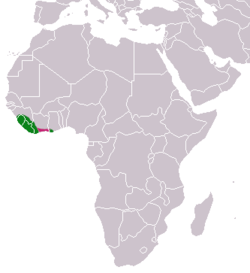Distribution and habitat
Johnston's genet is found in the Upper Guinean forests along the north west coast of Africa, across the countries of Guinea, Sierra Leone, Liberia, Ghana and the Ivory Coast. [4] In January 2000, a dead individual was recovered in Taï National Park in Ivory Coast, and the first live individual was captured in July 2000. [5] In 2011, it was recorded in the wild for the first time in Dindefelo Nature Reserve, a protected area in southeastern Senegal. [6]
Behaviour and ecology
Johnston's genet is predominantly nocturnal, feeding at night, and returning to its perch in the early morning. It spends the day sleeping and resting on tree tops. Its diet largely consists of insects, and small animals. It is vulnerable to being hunted by land based predators such as cheetahs, and leopards, and large birds such as eagles. It is also affected by various parasites such as ticks. It gives birth during the wet season, when prey is in abundance, and generally has a maximum litter size of two individuals. [4]
This page is based on this
Wikipedia article Text is available under the
CC BY-SA 4.0 license; additional terms may apply.
Images, videos and audio are available under their respective licenses.


